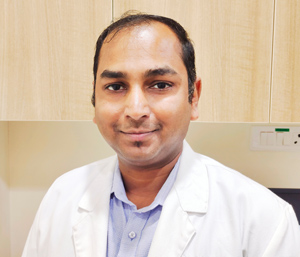 |
| Dr Deepak Kumar Consultant Radiation Oncologist RCHRC |
Radiation therapy is a vital component of cancer treatment. It is a painless, non-operative way of treating cancer. It is used in the treatment of every site of the disease. Patients of all age groups can be treated with radiotherapy depending upon the site of origin of cancer.
Radiation therapy can be used as a curative approach or as a post-operative treatment to eradicate the microscopic lesion/ disease, or for restraining growth of the disease. In palliative care, radiation therapy can be used to provide relief from pain or bleeding.
Radiation therapy is also used as a curative approach in disease sites where surgery is not possible due to excessive side effects. For example in cancers of the base of the tongue, neck or voice box, surgery may result in complications and impact the patient’s quality of life adversely. Radiation therapy for these sites can be successfully done and with good control of the disease. Also, by preserving the organ, the patient’s quality of life of could be maintained. Additionally, this therapy gives minimal to bearable side effects in the later years of one’s life.
In early-stage cervical cancer cases radiation therapy has proven to be as beneficial as surgical treatment but with lesser complications. Also, in cancers of the lung, esophagus, prostate, rectum, anal canal, brain tumour and skin malignancies radiation therapy is being used as an effective curative therapy.
In cancers of the oral cavity, neck, lung, stomach, gall bladder, soft tissue sarcoma, and brain tumour, radiation therapy has proven to be effective in controlling the disease post the surgery, that too with minimal complications. Receiving radiation therapy after surgery, eradicates microscopic disease, reduces the risk of recurrence and hence gives better control over disease.
Patients presenting with advanced stages of the disease often have excruciating pain and are usually resistant to conventional painkillers. Even in these situations, radiation therapy helps in relieving pain effectively in a short duration for a longer period.
Furthermore, in a few situations such as excessive bleeding or rapid proliferation of tumours can be controlled within a few days and sometimes even in hours by meticulous delivery of radiation therapy.
With the advancement of science, newer technologies for radiation therapy have evolved, the most advanced being precision radiation therapy.
With the help of precision technology, radiation therapy can be delivered using modern machines called linear accelerators or LINAC, causing minimal side effects to the tissue and organs closer to the diseased site. Using precision technology, small tumours in the brain or elsewhere in the body can be effectively cured by delivering a high dose of radiation therapy called stereotactic radiation therapy.
Additionally, tumours present in moving organs such as the lungs, liver, and stomach can be effectively treated by using motion management technique during radiation therapy. This technique is called 4Dgating where treatment is synchronised with respiratory movements. As an example, tumour situated in the lung is safely treated in a particular phase of the respiratory cycle which is monitored with a 4D gated device.
This technique is also used to treat cancer in the left breast, where radiation is delivered when the patient takes deep inhalation and holds her breath for a few seconds. Radiation thus delivered does not impact the heart adversely and treats the diseased site.
Brachytherapy is another way of delivering treatment where radiation is delivered through a live source channelled through an applicator. This is a very effective and more precise way of delivering radiation therapy only to tumour volume while sparing the normal tissue.
While brachytherapy can be used to deliver radiation for most cancer sites, it is the main component of treatment in the disease arising from the cervix and endometrium. Curing prostate cancer by Brachytherapy is equivalent to surgery with very minimal or no side effects.
In cancer of the oral cavity, especially in early stages, the disease can be completely cured by brachytherapy with equivalent results as surgery. At the same time the organ is preserved, and there are no scar marks, which makes it aesthetically more appealing.
- The Article is written by Dr Deepak Kumar, Consultant Radiation Oncologist at Ranchi Cancer Hospital and Research Centre, a unit of Tata Cancer Care Foundation. Ranchi Cancer Hospital and Research Centre is committed to providing comprehensive cancer care.
We have updated our policy. By continuing to browse this website, you agree to our privacy policy and the use of cookies on the website.